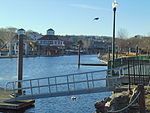Jail Hill Historic District
Historic districts in New London County, ConnecticutHistoric districts on the National Register of Historic Places in ConnecticutNRHP infobox with nocatNational Register of Historic Places in New London County, ConnecticutNorwich, Connecticut

The Jail Hill Historic District encompasses a 19th-century working-class residential district in Norwich, Connecticut. Located on a steep hill overlooking downtown Norwich, it was populated first by African Americans, and then by Irish immigrants. Some early African-American residents played significant roles in bringing expanded rights and education to others. The district was added to the National Register of Historic Places on April 19, 1999.
Excerpt from the Wikipedia article Jail Hill Historic District (License: CC BY-SA 3.0, Authors, Images).Jail Hill Historic District
Fountain Street, Norwich
Geographical coordinates (GPS) Address Nearby Places Show on map
Geographical coordinates (GPS)
| Latitude | Longitude |
|---|---|
| N 41.527222222222 ° | E -72.079722222222 ° |
Address
Fountain Street 50
06360 Norwich
Connecticut, United States
Open on Google Maps










